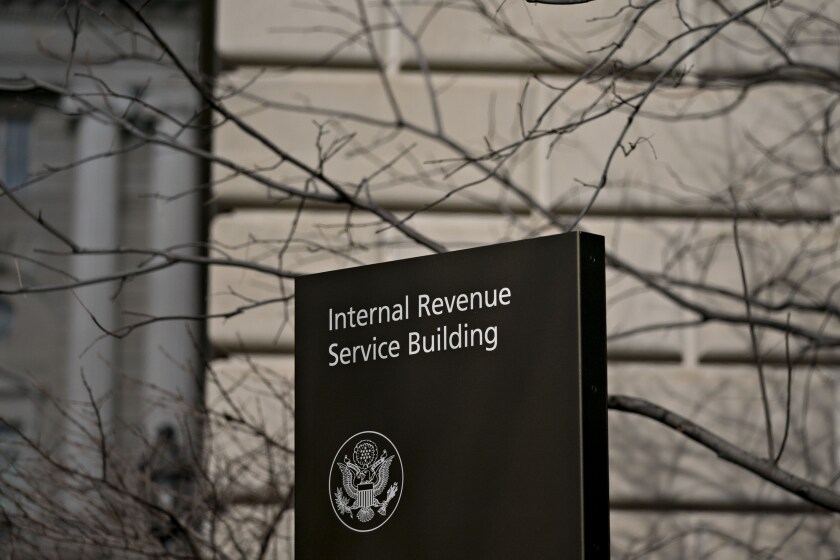The Internal Revenue Service has posted information on how people who weren’t supposed to receive their economic impact payments for the novel coronavirus pandemic should return the money.
The CARES Act, the $2.2 trillion stimulus package that Congress passed last month, included provisions for sending economic impact payments of at least $1,200 to individuals, and $2,400 to married couples, plus $500 per dependent child. However, the program has been beset by problems since it was rolled out. The IRS had to rely on information from taxpayers’ 2018 and 2019 tax returns to send the money. If taxpayers still had the same bank account listed for direct deposit, that expedited the process. However, many taxpayers had their tax refunds from those years sent to temporary bank accounts set up by their tax preparers and couldn’t access the stimulus payments, so they had to give the IRS their right bank account to deposit it. Others who have moved had to tell the IRS their new address. In many cases, the IRS sent the wrong amount or didn’t include the extra payment for their children, giving taxpayers a short window to try to update their information, or else wait until next year to get the extra money. In some cases, the IRS sent money to the families of deceased taxpayers or people who live abroad and don’t qualify for the payment. Undocumented and incarcerated taxpayers also aren’t considered to be eligible.
As Vice President, Underwriting Research and Development, Jackie Waas is involved in investigating and developing underwriting innovations, with an emphasis on concept development, research, presenting new ideas, and participating in concept validation activities.
She started her career with RGA in 2018 as Director of Underwriting Services, where she supported direct-to-consumer accelerated offerings, including assisting with the auditing of the e-underwriting program and helping develop digital health scores while supporting the Digital Health Data team.
Prior to joining RGA, Jackie was an Underwriting Business Consultant and automated underwriting systems subject matter expert with Legal & General America for four years after working in an underwriting capacity with the company for nine years. She also had five years of underwriting experience with AXA Equitable and formerly worked as a marketing manager for Steele Rubber Products.
Jackie received a Bachelor of Arts with a major in communications and a minor in psychology from Lenoir-Rhyne University in North Carolina. She is a Certified Fellow of the Academy of Life Underwriting, a Fellow of the Life Management Institute, and a Fellow of the Financial Services Institute. She is also an Associate, Reinsurance Administration; Associate, Insurance Agency Administration; and an Associate, Insurance Regulatory Compliance. Jackie also holds the Professional, Customer Service Institute designation, and she is a member of the Association of Home Office Underwriters.
Guizhou Hu is Vice President, VP, Head of Risk Analytics at RGA, where he supports global RGA underwriting initiatives and produces internal and external thought leadership pieces based on RGA's in-depth risk analytics. Before joining RGA in 2018, Guizhou served as Vice President, Chief Decision Analytics, for Gen Re and as a Senior Vice President for BioSignia Inc. Guizhou holds a medical degree from Beijing Medical University and a Ph.D. in Philosophy from Cornell University.
The IRS set up a Frequently Asked Questions page on its website about the economic impact payments and it has been adding more information to it as questions and problems have arisen. On Wednesday, the IRS added information to the page about which taxpayers are ineligible and how to return the payments if they received the money, including deceased, incarcerated and undocumented taxpayers.
For the families of deceased taxpayers, the IRS said, “A Payment made to someone who died before receipt of the Payment should be returned to the IRS by following the instructions about repayment. Return the entire Payment unless the Payment was made to joint filers and one spouse had not died before receipt of the Payment, in which case, you only need to return the portion of the Payment made on account of the decedent. This amount will be $1,200 unless adjusted gross income exceeded $150,000.”
For incarcerated taxpayers, the IRS said, “A Payment made to someone who is incarcerated should be returned to the IRS by following the instructions about repayments. A person is incarcerated if he or she is described in one or more of clauses (i) through (v) of Section 202(x)(1)(A) of the Social Security Act (42 U.S.C. § 402(x)(1)(A)(i) through (v)). For a Payment made with respect to a joint return where only one spouse is incarcerated, you only need to return the portion of the Payment made on account of the incarcerated spouse. This amount will be $1,200 unless adjusted gross income exceeded $150,000.”
For undocumented taxpayers, the IRS advised, “A person who is a non-resident alien in 2020 is not eligible for the Payment. A person who is a qualifying resident alien with a valid SSN is eligible for the Payment only if he or she is a qualifying resident alien in 2020 and could not be claimed as a dependent of another taxpayer for 2020. Aliens who received a Payment but are not qualifying resident aliens for 2020 should return the Payment to the IRS by following the instructions about repayments.”
If the payment was a paper check, the IRS gave the following instructions:
1. Write "Void" in the endorsement section on the back of the check.
2. Mail the voided Treasury check immediately to the appropriate IRS location listed below.
3. Don't staple, bend, or paper clip the check.
4. Include a note stating the reason for returning the check.
If the payment was a paper check and the taxpayer has cashed it, or if the payment was a direct deposit, the IRS recommended that taxpayers:
1. Submit a personal check, money order, etc., immediately to the appropriate IRS location listed below.
2. Write on the check/money order made payable to “U.S. Treasury” and write 2020EIP, and the taxpayer identification number (Social Security number, or individual taxpayer identification number) of the recipient of the check.
3. Include a brief explanation of the reason for returning the EIP.
For paper checks, the IRS then goes on to provide a list of IRS mailing addresses to use based on the state.



